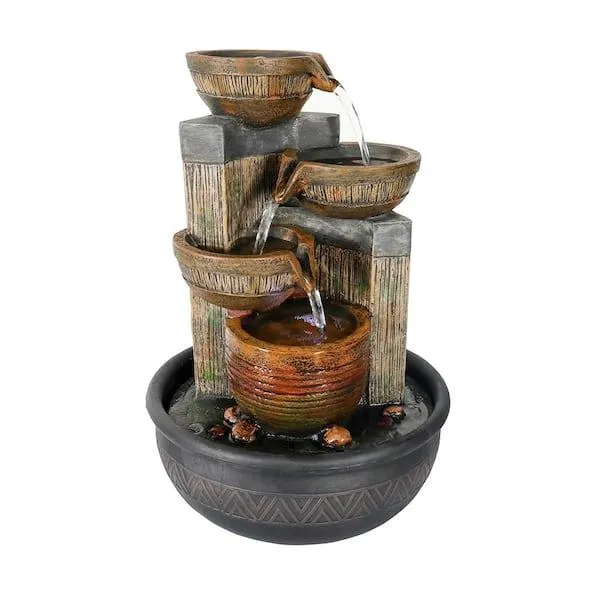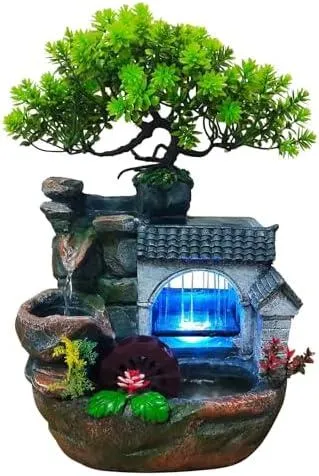Everything You Need to Know About Artificial Waterfall Plants
If you’re searching for “artificial waterfall plants,” you’re likely interested in adding the look of a miniature waterfall to your home or garden without the hassle of plumbing. Artificial waterfall plants are a great low-maintenance option that can provide a calming, natural vibe. In this article, I’ll cover everything you need to know to choose the right artificial waterfall plants and care for them.
Types of Artificial Waterfall Plants
There are a few different types of artificial waterfall plants to choose from:
- Hanging planters: These come in terra cotta or resin planters that hang from the ceiling or wall and have artificial greenery and vines spilling over the sides. Water flows down the front to resemble a miniature waterfall.
- Tabletop fountains: Small freestanding fountains have the look of plants and mosses surrounding a central waterfall feature. They’re a great size for desktops.
- Floor fountains: Larger floor fountains have the same planted look as tabletop versions but are taller for standing on the ground. Sizes range from 2-4 feet tall.
Choosing the Right Artificial Waterfall Plant
When selecting artificial waterfall plants, consider these factors:
- Size: Measure your space and choose a size that will fit appropriately without being too large or small. Tabletop options work well for desks while floor fountains suit larger indoor or outdoor areas.
- Style: Somehave a classic tiered fountain look while others resemble drooping vines or hanging gardens. Choose one that matches your home’s style. Tropical plants suit beachy decor.
- Material: Hanging planters are often terra cotta or resin, while fountains can have wood, stone, or resin elements. Consider durability for high-traffic areas.
- Lighting: If you want a lit fountain, check that model offers built-in LEDs or accepts light bulbs. Lights create an enchanting effect at night.
From my experience, paying a bit more for a higher-quality brand ensures longer lasting, more realistic artificial plants. Cheaper varieties tend to fade or look plastic-y faster over time.

Setting Up Your Artificial Waterfall Plant
Setting up artificial waterfall plants is simple, though follow all included instructions:
- Choose a level surface that can hold the fountain’s weight when full of water. Place outdoors or near a window if indoors for the waterfall effect.
- Fill the basin or reservoir with tap water, being careful not to overfill. Avoid soft or distilled water which may stain the fountain.
- Plug in a submersible pump and allow it to circulate the water. Heavier buildup may require occasional cleaning.
- For hanging fountains, attach the planter securely to a beam or wall using the included hardware. Adjust chains or ropes for your desired height.
- Add or replace artificial greenery as needed for a full look. Enjoy your new indoor garden addition!
The key is simple cleaning and pump or battery maintenance to keep your waterfall plants functioning properly for years. With a little care, they’ll provide a calming garden ambiance indoors or out.
FAQs About Artificial Waterfall Plants
Here are answers to some common questions people have:
- How long do the plants and pump last? Higher quality faux plants can look fresh for 5+ years. Pumps usually need replacing every 1-3 years depending on use.
- Do they require much care? No, once initially filled they’re low maintenance. Occasional light cleaning keeps algae at bay.
- Are they realistic looking? Yes, advances in artificial plant technology make them remarkably life-like to the average viewer from a distance. Up close you can see they’re not living.
- Can they be used indoors or out? Most tabletop and hanging styles can be placed indoors near a light source or outdoors on a covered patio. Floor fountains are best for outdoor use.
- Will animals/children be safe? Water is typically only an inch or two deep, posing no safety risk. Animated styles may interest toddlers, so watch them closely.
With proper care, artificial waterfall plants can last many scenic years enhancing your home or yard. They’re low risk and basically maintenance-free, so you can create a garden sitting or standing area with ease.

Styling Tips for Artificial Waterfall Plants
To get the most out of your waterfall feature, consider these styling ideas:
- Surround it with pebbles, plants or moss to resemble its natural surroundings. Moss looks super lush from a distance.
- For a zen vibe, place smooth river rocks in the water’s path. Ripples over stone is calming to see and hear.
- Add props like a wooden bridge, buddha statue or lanterns near the waterfall for visual interest.
- Use trailing vines to spill over the fountain’s edges and onto surrounding surfaces like shelves or the floor.
- For outdoor use near patio seating, consider string lights overhead on an evening timer for a serene ambiance after dark.
Even simple artificial falls allow creativity. Let yours be an inviting focal point through clever accessorizing and arrangement. Your space will feel like an oasis in no time!
In Closing Thoughts
Whether indoors on a mantle or outside by the garden, an artificial waterfall plant is a low-effort way to bring bucolic charm and the soothing sound of dripping water. With the right care and placement, yours can provide scenic relaxation for years to come. I hope this guide has helped answer your intentions and you now feel confident selecting the perfect faux garden accessory for your style and space. Let me know if you have any other questions!
Factors to Consider When Choosing an Artificial Waterfall Plant
| Plant Type | Water Needs | Light Requirements | Size |
|---|---|---|---|
| Ivy | Moderate | Medium | Trailing vines up to 10 feet |
| Philodendron | Low | Low to Medium | Leaves up to 10 inches |
| Pothos | Low | Low to Medium | Trailing vines up to 10 feet |
| Peace Lily | Moderate | Medium to High | Leaves 8-12 inches, flowers 1-2 feet tall |
| Ferns | High | Medium to High | Fronds from 6 inches to 3 feet |
FAQ
-
What are the basics of artificial waterfall plants?
Basically, artificial waterfall plants look similar to real plants but don’t require sunlight, water or soil to survive. They’re made of materials like plastic, silk or paper which allows them to hold a natural plant-like shape for a long time.

-
How can artificial plants add value to my home or office?
At the same time, putting up fake foliage is kind of like getting a new decor item for very little effort. They can make a space appear livelier and fresher. Plus, artificial plants sort of never die so you don’t have to stress over watering them. Might be worth a shot if you’re goin’ for that lush tropical vibe!
-
Do artificial plants look realistic?
Despite what you might think, the quality of fake greenery has come a long way. These days they can fool just about anyone – the leaves often have varied colors and textures similar to real plants. Perhaps the biggest tell is they don’t sway or move with airflow. But is that worth worrying about if they’re low maintenance? You be the judge!
-
How do I care for artificial plants?
Most require little to no care at all. Basically just dust them occasional to prevent a film from building up. You may want to fluff the leaves now and then so they keep their volume. Some people even claim spraying them with water helps maintain a genuine plant-like appearance long-term. Crazy, right? Still, low effort for that luxury jungle feel.
Are artificial plants harmful in any way?
On the other hand, there are some thoughts that the materials used might off-gas toxic chemicals or collect lots of dust over time. However, most retailers claim their faux foliage meets various safety standards. And let’s be real – unless you’re performing extensive scientific testing, who actually knows for sure? Maybe go for a potted real plant too if you’re really worried. Can’t hurt to take precautions!

How long do artificial plants last?
If properly cared for, many people say their fake houseplants have lasted years and years. The plastic varieties might last a decade or more with just simple cleaning. Paper ones tend to yellow or degrade quicker. But overall, for the small financial investment, they can survive way longer than the average real plant. Kinda makes you wonder if anyone’s artificial tree is officially a senior citizen yet!
Should I get an artificial or real plant?
Honestly it depends on your needs and preferences. Real plants have benefits like improving air quality and adding color variation as they grow. But artificial get points for low maintenance – you don’t need to stress over watering on vacation! Maybe a mix of both is ideal so you get benefits of each. What are your thoughts – do the pros outweigh the cons in either direction? I’d love other perspectives on this debate if anyone has strong feelings to share.
